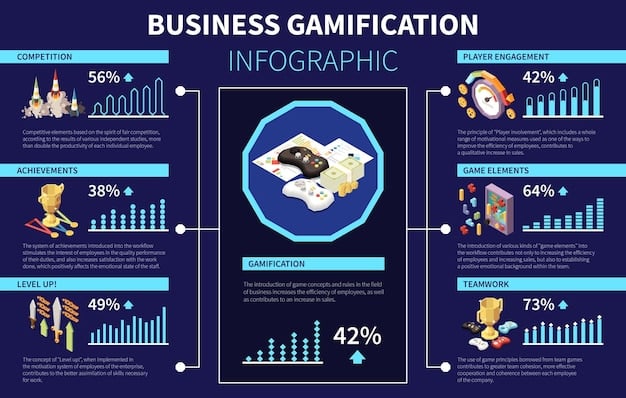Esports Sponsorship Deals in the US: Top Investors in 2025

In 2025, the US esports sponsorship landscape is dominated by tech giants, energy drink companies, and automotive brands, reflecting the industry’s growing appeal and lucrative marketing opportunities.
The world of esports is rapidly expanding, and the United States is at the forefront of this growth. With millions of viewers and a highly engaged audience, esports has become a prime target for sponsorship. So, who’s leading the charge in **Esports Sponsorship Deals in the US: Which Companies are Investing the Most in 2025**?
Understanding the Esports Sponsorship Landscape in the US
Esports sponsorships are a significant revenue stream for teams, leagues, and individual players. These deals provide financial backing that fuels growth and development within the industry. In the US, the esports market is particularly attractive due to its large and diverse audience, making it a key battleground for brands seeking to connect with younger demographics.
Understanding the key players and trends in this landscape is crucial for anyone looking to enter or expand their involvement in esports. In 2025, several factors will influence which companies invest the most, including audience reach, brand alignment, and the overall health of the esports ecosystem.
Key Trends Shaping Esports Sponsorship in 2025
Several trends are shaping the landscape of esports sponsorships in the US. These include the increasing professionalization of esports, the rise of mobile gaming, and the growing popularity of esports among mainstream audiences.
- Professionalization: As esports becomes more organized and structured, with established leagues and regulations, it attracts more traditional sports sponsors.
- Mobile Gaming: The rise of mobile esports opens up new sponsorship opportunities, particularly for mobile-first brands and telecom companies.
- Mainstream Appeal: As esports gains broader acceptance, more non-endemic brands (those not traditionally involved in gaming) are entering the space, seeking to tap into its valuable audience.
These trends create a dynamic environment where companies must adapt their strategies to effectively reach esports fans. This includes understanding the unique characteristics of different esports titles and target audiences.
Top Companies Investing in US Esports in 2025
In 2025, several companies stand out as major investors in the US esports scene. These companies span various industries, including technology, energy drinks, automotive, and consumer goods. Their investments take various forms, from team sponsorships to league partnerships and event sponsorships.
These companies see esports as a valuable marketing platform to reach a young, digitally native audience. By aligning themselves with popular esports teams and events, they gain brand visibility and build relationships with potential customers.

Notable Sponsors and Their Esports Strategies
Let’s take a closer look at some of the top companies investing in US esports in 2025 and the strategies they employ to maximize their impact.
- Tech Giants: Companies like Intel, NVIDIA, and Samsung continue to be major players, providing hardware and technology infrastructure that powers esports.
- Energy Drink Brands: Red Bull and Monster Energy remain heavily involved, sponsoring teams, events, and individual players.
- Automotive Companies: Brands like BMW and Toyota are increasingly investing in esports, seeing it as a way to connect with younger car buyers.
These companies utilize a mix of traditional sponsorship tactics and innovative approaches, such as creating branded content, hosting esports tournaments, and partnering with influencers to promote their products and services.
The Role of Endemic vs. Non-Endemic Sponsors
Esports sponsorships can be broadly categorized into two types: endemic and non-endemic. Endemic sponsors are those that are naturally aligned with the gaming industry, such as hardware manufacturers and gaming peripheral companies. Non-endemic sponsors come from outside the gaming world, such as automotive brands and fast-food chains.
Both types of sponsors play a crucial role in supporting the esports ecosystem. Endemic sponsors provide essential technology and equipment, while non-endemic sponsors bring in new revenue streams and help broaden the appeal of esports to a wider audience.
Benefits of Endemic Sponsorships
Endemic sponsorships offer several benefits, including:
- Authenticity: Endemic brands are inherently credible within the esports community, as they provide products and services that gamers use and value.
- Targeted Reach: They can directly reach their target audience through esports sponsorships, as esports fans are often their primary customers.
- Product Integration: Endemic sponsors can seamlessly integrate their products into esports events and broadcasts, showcasing their capabilities and benefits.
Benefits of Non-Endemic Sponsorships
Non-endemic sponsorships also offer unique advantages, such as:
- Broader Exposure: They can reach a new and engaged audience that may not be familiar with their brand.
- Brand Building: Non-endemic sponsors can associate their brand with the excitement and innovation of esports, enhancing their image and appeal.
- Revenue Diversification: They provide additional financial support to the esports ecosystem, helping it to grow and thrive.
The ideal sponsorship strategy often involves a mix of both endemic and non-endemic partners, creating a balanced and sustainable ecosystem.
The Impact of Esports Sponsorship on Team Performance and Growth
Esports sponsorships have a direct impact on the performance and growth of teams. The financial backing provided by sponsors allows teams to invest in better training facilities, coaching staff, and player salaries. This, in turn, can lead to improved performance and greater success in competitions.
Furthermore, sponsorships help teams to build their brand and attract new fans. By associating with well-known and respected brands, teams can enhance their credibility and appeal, making them more attractive to potential partners and investors.
Case Studies of Successful Esports Sponsorships
Several case studies illustrate the positive impact of esports sponsorships on team performance and growth.
- Team Liquid and Alienware: The long-standing partnership between Team Liquid and Alienware has provided the team with cutting-edge hardware and technology, helping them to stay at the forefront of competitive gaming.
- Cloud9 and BMW: The sponsorship deal between Cloud9 and BMW has enabled the team to expand their operations and invest in new talent, contributing to their continued success.
- TSM and Logitech G: TSM’s partnership with Logitech G has provided their players with high-quality peripherals, giving them a competitive edge in tournaments.
These examples demonstrate how strategic sponsorships can provide teams with the resources and support they need to achieve their goals.
Measuring the ROI of Esports Sponsorships
Measuring the return on investment (ROI) of esports sponsorships can be challenging, but it’s essential for companies to determine the effectiveness of their investments. Several metrics can be used to assess the ROI of esports sponsorships, including brand awareness, audience reach, engagement, and sales.
Companies are increasingly using data analytics and tracking tools to measure the impact of their esports sponsorships. This allows them to gain insights into audience demographics, engagement patterns, and the correlation between sponsorship activities and business outcomes.

Key Metrics for Evaluating Esports Sponsorship ROI
Here are some key metrics that companies use to evaluate the ROI of their esports sponsorships:
- Brand Awareness: Tracking the increase in brand recognition and recall among esports fans.
- Audience Reach: Measuring the number of viewers and participants exposed to the sponsored content.
- Engagement: Assessing the level of interaction and participation with the sponsored content, such as likes, shares, and comments.
- Sales: Analyzing the correlation between sponsorship activities and sales revenue.
By tracking these metrics, companies can gain a comprehensive understanding of the value of their esports sponsorships and make informed decisions about future investments.
The Future of Esports Sponsorship in the US
The future of esports sponsorship in the US looks bright, with continued growth and innovation expected in the coming years. As esports becomes more mainstream and attracts a wider audience, more companies are likely to enter the space, seeking to tap into its valuable marketing opportunities.
We can expect to see more creative and integrated sponsorship activations, as companies look for new ways to engage with esports fans. This could include virtual product placement, augmented reality experiences, and personalized content.
Emerging Trends in Esports Sponsorship
Some emerging trends in esports sponsorship include:
- Micro-Influencer Marketing: Partnering with smaller, more specialized influencers to reach specific esports communities.
- Data-Driven Sponsorships: Using data analytics to optimize sponsorship activations and improve ROI.
- Personalized Experiences: Creating tailored experiences for esports fans based on their preferences and behaviors.
These trends reflect the growing sophistication of the esports sponsorship landscape, as companies seek to maximize their impact and connect with fans on a deeper level.
| Key Point | Brief Description |
|---|---|
| 🎮 Growing Popularity | Esports increases popularity, attracting varied sponsors. |
| 📈 Investment Surge | Companies enhance sponsorship deals reflecting esports lucrativeness. |
| 🤝 Brand Alignment | Sponsors seek alignment enhancing brand visibility and loyalty. |
| 📊 ROI Measurement | Metrics are crucial for sponsors assessing deal performance. |
FAQ
▼
Esports teams are sponsored by a range of companies, including tech, energy drinks, automotive, and apparel brands. These sponsorships help support the teams financially and provide resources for growth.
▼
Sponsorships provide financial support that allows teams to invest in better training facilities, coaching staff, and player salaries. This helps improve performance and overall team development.
▼
Key metrics include brand awareness, audience reach, engagement, and sales. These metrics help companies evaluate the effectiveness of their esports sponsorship investments.
▼
Endemic sponsors, like hardware and peripheral companies, provide essential technology and infrastructure. Their support is pivotal for the gaming community and esports ecosystem.
▼
Future trends include micro-influencer marketing, data-driven sponsorships, and personalized experiences. Brands will increasingly seek unique ways to engage with esports fans.
Conclusion
As we look ahead to 2025, the esports sponsorship landscape in the US promises to be dynamic and full of opportunity. With increasing investment from both endemic and non-endemic brands, esports teams, leagues, and players will continue to benefit from the financial backing needed to fuel their growth. By understanding the key trends and leveraging data-driven strategies, companies can effectively tap into the valuable esports audience and achieve a strong return on their investment.





